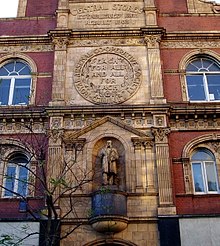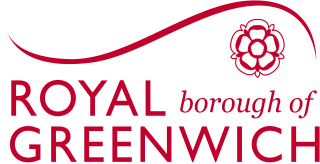
The Royal Borough of Greenwich is a London borough in southeast Greater London. The London Borough of Greenwich was formed in 1965 by the London Government Act 1963. The new borough covered the former area of the Metropolitan Borough of Greenwich and part of the Metropolitan Borough of Woolwich to the east. The local council is Greenwich London Borough Council which meets in Woolwich Town Hall. The council's offices are also based in Woolwich, the main urban centre in the borough.

Woolwich is a district in southeast London, England, within the Royal Borough of Greenwich.

The Royal Arsenal, Woolwich is an establishment on the south bank of the River Thames in Woolwich in south-east London, England, that was used for the manufacture of armaments and ammunition, proofing, and explosives research for the British armed forces. It was originally known as the Woolwich Warren, having begun on land previously used as a domestic warren in the grounds of a Tudor house, Tower Place. Much of the initial history of the site is linked with that of the Office of Ordnance, which purchased the Warren in the late 17th century in order to expand an earlier base at Gun Wharf in Woolwich Dockyard.

Eltham is a district of southeast London, England, within the Royal Borough of Greenwich. It is 8.7 miles (14.0 km) east-southeast of Charing Cross, and is identified in the London Plan as one of 35 major centres in Greater London. The three wards of Eltham North, South and West have a total population of 35,459. 88,000 people live in Eltham.
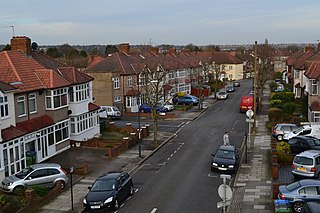
New Eltham is an area of south east London, in the London Boroughs of Greenwich and Bexley. It lies south east of Eltham and north west of Sidcup.

Woolwich Common is a common in Woolwich in southeast London, England. It is partly used as military land and partly as an urban park. Woolwich Common is a conservation area. It is part of the South East London Green Chain. It is also the name of a street on the east side of the common, as well as an electoral ward of the Royal Borough of Greenwich. The population of the ward at the 2011 Census was 17,499.
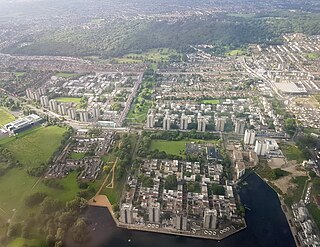
Abbey Wood is an area in south east London, England, straddling the border between the Royal Borough of Greenwich and the London Borough of Bexley. It is located 10.6 miles (17 km) east of Charing Cross.
The London Co-operative Society (LCS) was a consumer co-operative society in the United Kingdom.
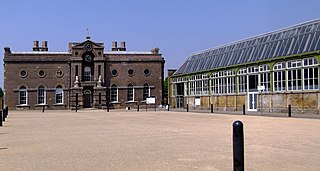
Greenwich Heritage Centre was a museum and local history resource centre in Woolwich, south-east London, England. It was established in 2003 by the London Borough of Greenwich and was run from 2014 by the Royal Greenwich Heritage Trust until the centre's closure in July 2018. The museum was based in a historic building in Artillery Square, in the Royal Arsenal complex, which was established in the 17th century as a repository and manufactory of heavy guns, ammunition and other military ware.
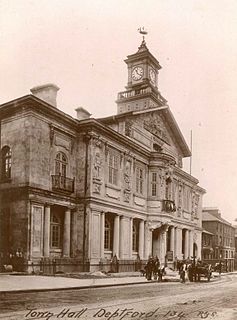
Walter Henry Green was a British Labour and Co-operative politician for Deptford, elected in 1935 and MP until 1945. He became a councillor in Deptford in 1909, its mayor 1920–1922, and in 1944 became the first freeman of the borough. Later he became a member of the Metropolitan Water Board 1946–1953, and was appointed the C.B.E. Order of the British Empire in 1949.
Henry John May was a British co-operative movement activist and from 1913 to 1939 he was Secretary of the International Co-operative Alliance.

Well Hall is a place to the north of Eltham in the Royal Borough of Greenwich in southeast London, England, with no present formal boundaries and located 13.5 km (8.4 mi) east-southeast of Charing Cross. In the past Well Hall was the grounds of a manor house, and then a hamlet. Today it is a largely residential suburb and housing estate absorbed by the development of Eltham and London. It is centred on the main road between Eltham and Woolwich, on which many shops and businesses are located. Several major A roads including the South Circular Road and A2 road pass through the area, as does a railway line, serving Eltham station which is located in Well Hall. The Postcode that covers Well Hall and most of the Eltham area is SE9, and the 020 dialing covers the entire Royal Borough of Greenwich. Well Hall is split across two electoral wards, Eltham West on the west side of Well Hall Road, and Eltham North on the east side of Well Hall Road. In 2015 the population of these two wards combined was recorded as 24,621, although the wards cover a larger area than just Well Hall.
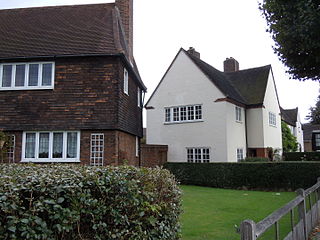
The Progress Estate is a housing estate located in Well Hall, Eltham, in the Royal Borough of Greenwich, South East London. It was built in 1915 to house some of the senior and skilled workers employed at the nearby Royal Arsenal munitions factories in Woolwich.

Woolwich Town Hall is an early 20th-century town hall located in the historic Bathway Quarter in the centre of Woolwich, South East London. Until 1965 it was the seat of local government of the Metropolitan Borough of Woolwich, after which it became the headquarters of the Greenwich London Borough Council. It is a rare example of an Edwardian Baroque town hall in London and is a Grade II*-listed building.

Bathway Quarter is an area of historic interest in the centre of Woolwich, South East London. Most buildings in the Bathway Quarter are Grade II*, Grade II or locally listed, while the area as a whole is designated a conservation area by Greenwich Council. With the exception of the Old Town Hall, the listed buildings date from the late-19th or early-20th century. Several were designed by local architect Henry Hudson Church, their civic use reflected in their grand elevations formed of red brick with stone detailing.

St Peter's Church is a Roman Catholic church in Woolwich, South East London. It is situated between Woolwich New Road and Brookhill Road, the main entrance being on Woolwich New Road. The church was designed by Augustus Pugin in 1841–42 in the style of the Gothic Revival and is one of only three Pugin churches in London. Pugin's design remained unfinished as the projected tower and spire were never built. The parish of St Peter the Apostle serves the Catholic community of central Woolwich and surrounding areas, and is part of the Archdiocese of Southwark which is in the Province of Southwark.

Beresford Square is a pedestrianised town and market square in Woolwich in the Royal Borough of Greenwich in London, England. It was formed in the early 19th century and was named after the Anglo-Irish general William Beresford, Master-General of the Ordnance and Governor of the Royal Military Academy in Woolwich. With its lively street market and lined with shops, pubs and restaurants, Beresford Square has been the heart of Woolwich for over two centuries. Since 2019 the square is part of a conservation area.

Powis Street is a partly pedestrianised shopping street in Woolwich in the Royal Borough of Greenwich, south east London, England. It was laid out in the late 18th century and was named after the Powis brothers, who developed most of the land in this part of the town. The street has been rebuilt several times but has retained some notable examples of late-Victorian and Art Deco architecture. Since 2019 the street is part of a conservation area.

Old Woolwich or Woolwich Central Riverside is an area along the Thames in Woolwich, South East London. It is the oldest inhabited part of Woolwich, going back to an Anglo-Saxon riverside settlement. When the demographic centre of Woolwich shifted south in the 1800s, the area became a Victorian slum. Most of Old Woolwich was cleared in the 20th and early 21st centuries to make way for industrial, infrastructural and other large-scale developments. Although most of the earlier buildings have been demolished, the area has retained some interesting architecture, including the Georgian parish church, the Edwardian foot tunnel rotunda and two cinemas of the 1930s.

Woolwich Works, also known as Woolwich Creative District, is a multi-disciplinary cultural venue on the south bank of the River Thames in Woolwich in south-east London, that opened in September 2021. It occupies a range of historic buildings at the Royal Arsenal, and includes a 1200-seat auditorium for concerts and events, a performance courtyard that seats up to 600, as well as offices, studios and rehearsal spaces for resident companies. Future phases will include a 450-seat black box theatre and a riverside restaurant. Woolwich Works is situated close to the Royal Arsenal Pier and the new Woolwich Elizabeth line station.
